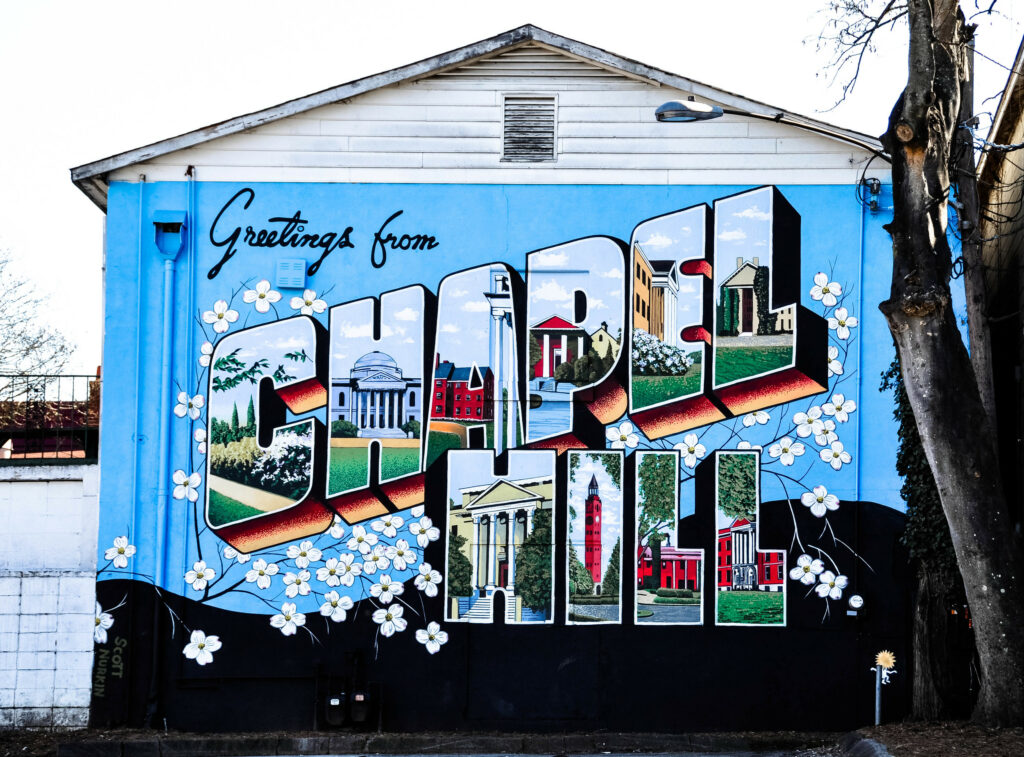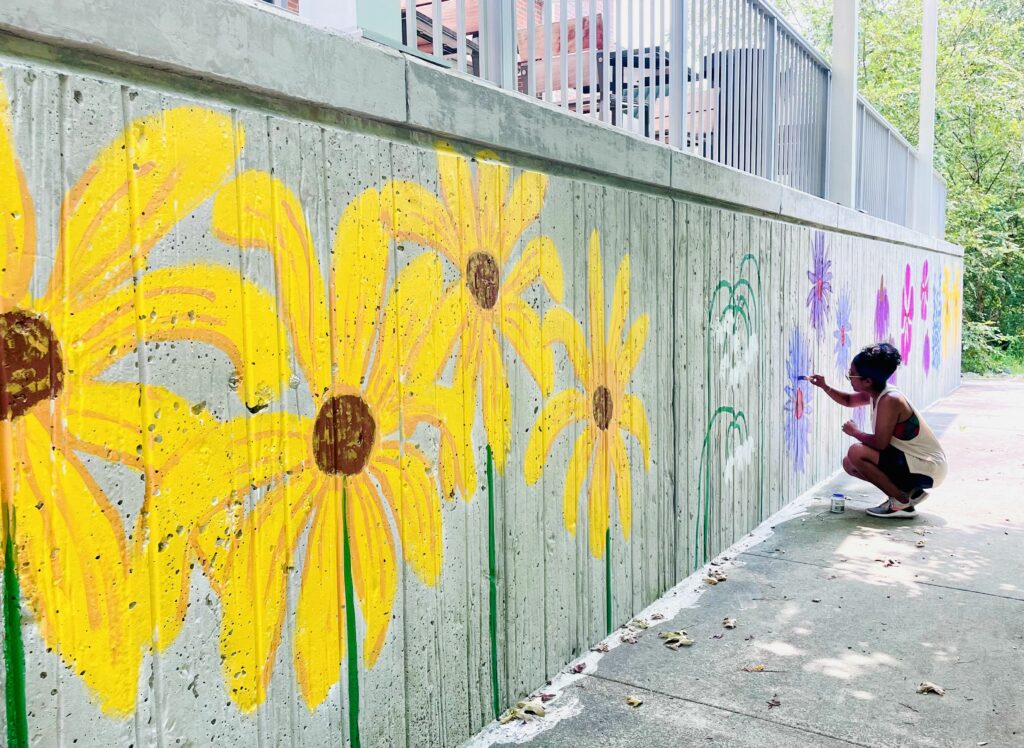Written by Teresa Fang, East Chapel Hill High School student
In Chapel Hill, the most popular hub of activity is Franklin Street, a locale synonymous with murals and public art — as seen in Chapel Hill’s unique Downtown Murals Map. Open and visible to visitors and photo-takers at any time of day, these murals represent various dreams, representations and history.
Art as a Message
Coined as “Chapel Hill’s Legendary Bar,” the iconic He’s Not Here is one of the most historic places on Franklin Street. The bar has rich stories of how it got its name, including one involving star alum Michael Jordan, but it has another story on the bar’s backside: the “Greetings from Chapel Hill” mural.

Muralist Scott Nurkin’s iconic work, “Greetings from Chapel Hill,” is turning 10 years old this year. (image via franklin&main)
The original artwork was a 1941 postcard by German illustrator Curt Teich, but this mural was painted onto the wall by local artist Scott Nurkin in 2013. Nurkin, a UNC alum (2000) and Charlotte native, is a regular muralist whose works can be seen all throughout town. He is grateful to his mentor, Michael Brown, who painted much of Chapel Hill’s public art back in the 1990s and some of which still stand today, including “Long Pencil” on Henderson Street.
Nurkin does his work both on-site and in different towns, but his favorite place to work is his studio located in an old building in Chapel Hill, where his Dean Smith portrait can be seen smiling nearby. Among the 19 murals Nurkin has done all over the state so far, Chapel Hill’s art has a special place in his heart.
“I wanted to paint a mural that was inarguably tied to our hometown. Something that instilled pride and was also welcoming to the many visitors, students, and potential visiting students and their families,” Nurkin said. “Plus, I knew folks would want to take a photo in front of it.”
Down the street, another restaurant was adorned with local art. Titled “Lotus Rising – An Ode to Women,” the mural was painted by Mayanthi Jayawardena to celebrate Women’s History Month and has received widespread acclaim.
For muralist Mayanthi Jayawardena, who has been painting murals for nearly three years, honoring history and spreading a message is what Jayawardena hopes her murals can bring to light. Tying to her own roots as a Sri Lankan American, the mural depicts lotus flowers and their ability to grow beautifully in mud, symbolizing the strength and resilience of women.

Muralist Mayanthi Jayawardena works on her newest artwork at the Chapel Hill Public Library. (image via Teresa Fang)
Art as a Community Impact
Ten years later, the “Greetings from Chapel Hill” mural continues to be one of the most frequented spots for students and tourists alike.
“Murals are fluid and temporary, they’re not marble statues,” Nurkin said. “If a mural stays up longer than five years, I consider it a big success, [because] they are meant to be painted over eventually.”
Before becoming a muralist, Jayawardena was a gallery artist. While painting murals can be a tremendous social collaboration, gallery artists have the freedom to tackle whatever they wanted for gallery paintings— something she hopes to continue in her murals. Reflecting on her own personal experiences, some specific messages she really wants to share include anxiety, mental health, and her second-generation immigrant story.
“I think my long-term goal is to really find that sweet spot where I’m painting fun, beautiful murals like this, and doing more advocacy, through art and sharing messages, that I think might just be able to impact people who are struggling with those issues or don’t know how to express themselves in those issues and might see themselves in my heart,” Jayawardena said.
Today, Jayawardena continues to brave the summer heat to make murals. During the time of this interview, she was working on a flower mural outside the Chapel Hill Public Library. Earlier that week, she had little helpers from a middle and high school summer camp who helped paint the flowers.
“I guess my goal is to create different spaces in the community where people can see themselves or get lost in something beautiful, something that takes them away from whatever I going on in their life and can stop time for them a little,” Jayawardena said. “As artists, if we can provide an escape to something positive, then I feel like I’m giving back. But honestly, that’s the journey.”
Chapelboro.com does not charge subscription fees, and you can directly support our efforts in local journalism here. Want more of what you see on Chapelboro? Let us bring free local news and community information to you by signing up for our biweekly newsletter.

